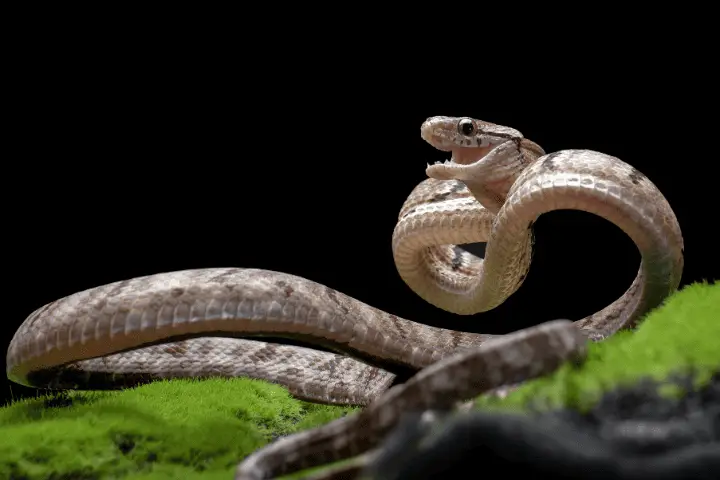Can Snakes Jump
Snakes are often seen slithering on the ground. But can they jump?
This article is here to shine a light on this puzzling question!
At first, snakes jumping appears paradoxical. They don’t have any limbs or appendages to help them leap off the ground.
But nature can be full of surprises. Certain snake species have actually been seen exhibiting ‘jumping’ behavior.
Snakes are more adaptable than we think when it comes to movement. We may not associate them with jumping, but their hidden talents make them amazing creatures.
Can Snakes Jump?
Snakes are truly mesmerizing. They have the ability to captivate humans for centuries.
Snakes don’t have powerful hind legs like frogs or kangaroos. Nor do they have a spring-like mechanism. Instead, they use their flexibility and muscle control to move atop different terrains.
Still, some species can do amazing aerial moves! Like the flying snake of Southeast Asia. These guys flatten their bodies and use gravity and muscle contractions to fly between trees with accuracy.
Also, certain snakes are capable of “snake propulsion”. By pushing against hard surfaces, they can launch themselves off the ground and cover great distances in seconds!
Did you know that snakes can reach speeds of up to 10 miles per hour while gliding or launching?
So, while snakes may not jump like other animals, they have developed unique techniques and adaptations which let them move in astonishing ways.
Snakes are truly incredible creatures that will keep amazing and scaring us!
Understanding Snake Movement
The movement of snakes is an interesting topic that captures the attention of both scientists and snake-lovers. They have a unique way of getting around, which is not like the movement of other animals.
Snakes are great at using their environment. Their long and bendy bodies let them move easily on land or in water.
The wave-like motion helps them get past obstacles, making them good hunters when they are after food.
Many people want to know if snakes can jump. In truth, they cannot jump off the ground like kangaroos or frogs.
However, some species can do ‘concertina locomotion’. This means they hold onto their tails and push the front part of their bodies forward, so it looks like they are jumping or leaping over things.
Not all snakes can do this. Boas and vipers that live in trees can do concertina locomotion to move from one branch to another.
This lets them cover bigger distances quickly and also stay away from danger on the ground.
Factors Affecting Snake Jumping Ability
Snake jumping ability is greatly impacted by several factors. These include body structure, muscle power, and environmental conditions.
Body structure is key. Length and flexibility, weight distribution – all affect a snake’s jumping prowess. Muscle power, too – strength and agility are essential for explosive jumps, plus energy reserves.
Even more amazing, some species possess adaptations to aid jumping. Tree-dwelling snakes have prehensile tails, for example. It’s incredible what snakes can do!
In a stunning discovery, evolutionary biologist Timothy Higham at Clemson University revealed that some snakes can launch themselves from coiled positions on flat surfaces.
This remarkable finding shows the huge agility and versatility of certain snakes.
Debunking Myths about Snake Jumping
Contrary to popular belief, snakes cannot jump like humans. No limbs mean no jumping.
But they do have other tricks up their scales. They use sidewinding or serpentine movements to move quickly.
They can’t launch themselves into the air. Only certain species like the flying snake can glide short distances.
What they can do though is propel themselves forward by pushing against objects or using their powerful muscles.
The idea that they can pounce on prey from a distance is due to how quickly they can strike. This gives the illusion of a leap.
Their capacity for movement is a result of their adaptability and anatomy.
Throughout history, many cultures have created stories of snakes jumping super far. These are either cautionary tales, or just embellished stories.
Examples of Snake Species That Can Jump
Snakes don’t usually come to mind when thinking of jumping creatures – but there are several species that can really leap!
These snakes have special adaptations that let them propel themselves through the air and travel impressive distances. Meet some of the most impressive jumpers:
- The Paradise Tree Snake (Chrysopelea paradisi) – Found in Asia, this snake can glide up to 100 meters from tree branch to tree branch!
- The Eastern Indigo Snake (Drymarchon couperi) – The longest native snake in North America, it can jump when threatened or startled.
- The Mangrove Cat Snake (Boiga dendrophila) – This Southeast Asian snake can surprise its prey by jumping from branch to branch!
- The African Twig Snake (Thelotornis kirtlandii) – It uses its prehensile tail to maneuver and jump off branches.
- The South American Bushmaster (Lachesis muta) – The largest venomous snake in the world can lunge and jump when attacking prey.
- The Tiger Ratsnake (Spilotes pullatus) – Found in Central and South America, it can jump from trees and catch birds mid-air!
These snakes’ remarkable jumping skills have enabled them to survive and thrive in their habitats. Even though not all snakes can jump, we can still appreciate their unique abilities.
If you ever find a jumping snake, stay alert and observe from a safe distance. Don’t make sudden movements or try to handle the snake!
Techniques for Snake Jumping
Snakes have no limbs, yet they can still fly! How? By using these unique techniques.
Coiling their bodies tightly and releasing tension, utilizing muscles to generate momentum, synchronizing movement of their tail, body, and muscles, using tails as leverage points, transferring energy from one part to another, and taking advantage of their flexibility.
These skills give us insight into how snakes defy gravity so gracefully.
Furthermore, snake species vary in their jumping abilities based on size, habitat, and hunting patterns.
One example is an olive python in Australia’s Northern Territory, who jumped over three meters to capture its prey.
It’s amazing that even with no arms or legs, snakes can still soar! Although, they’re quite good at scaring us too.
Conclusion
Snakes can’t jump. Their body shape and lack of legs make this impossible.
But they are great at moving around – slithering! This helps them in their natural habitats, as predators.
They are also very flexible. They have lots of vertebrae, and this lets them move into small areas to catch prey.
Their belly scales give them traction on surfaces so they can move without legs.

